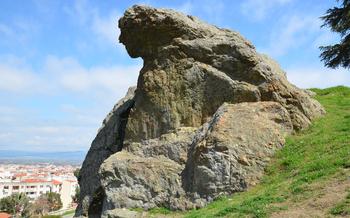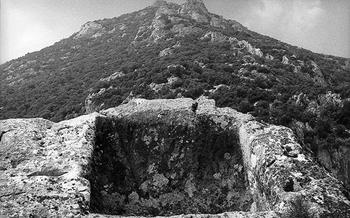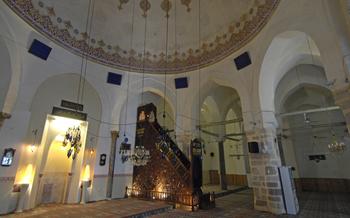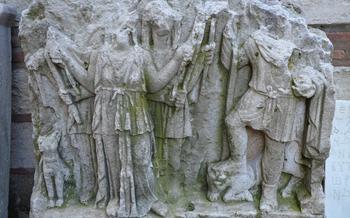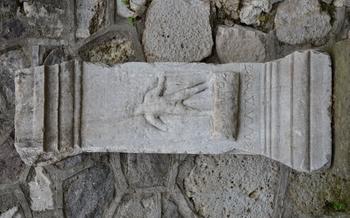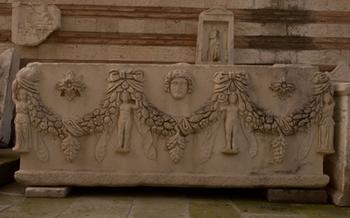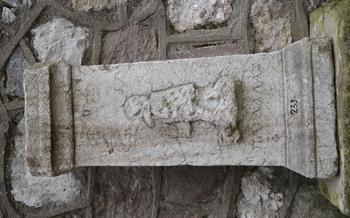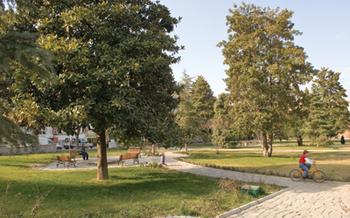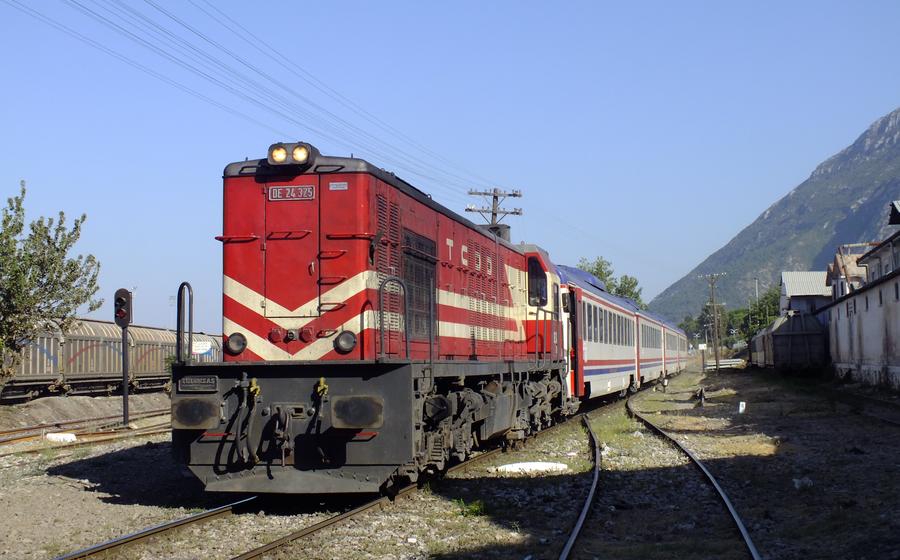
Bintepeler Lydian Necropolis
- History of the Bintepeler Lydian Necropolis
- Location and Accessibility
- Entrance Fees and Visiting Hours
- Conservation Efforts
- Historical Significance
- Unique Features
- Nearby Attractions:
- Tips for Visitors
- Photo Opportunities
- Local Cuisine
- Cultural Significance
- Historical Context
- Insider Tip:
History of the Bintepeler Lydian Necropolis
The Bintepeler Lydian Necropolis, an archaeological site of significant importance, is located in the region of Manisa in Turkey. It is a testament to the rich historical heritage of the Lydian kingdom, which flourished in the 7th century BC. The Lydians were an ancient Anatolian civilization renowned for their trade and commercial activities. Their kingdom extended across the western part of Asia Minor and was known for its wealth and cultural achievements.
The necropolis at Bintepeler serves as a valuable source of information about Lydian burial practices and their cultural beliefs. Excavations conducted at the site have revealed numerous tombs, each unique in its architectural features and decorative elements. The discovery of artifacts, including pottery, jewelry, and other objects, has further enriched our understanding of Lydian craftsmanship and artistry.
Location and Accessibility
The Bintepeler Lydian Necropolis is situated in the ancient city of Sardis, which was once the capital of the Lydian kingdom. The necropolis is located approximately 8 kilometers (5 miles) from the modern city of Manisa, in western Turkey. To reach Bintepeler, visitors can opt for a scenic 30-minute drive from Manisa city center. Public transportation options are also available, with regular buses departing from Manisa's main bus station and dropping off near the site's entrance.
For a comprehensive and immersive experience, consider embarking on a guided tour. These tours typically include round-trip transportation from your hotel, allowing you to relax and enjoy the journey. Tours often provide insightful commentary and historical context, enriching your understanding of the necropolis and its significance. Whether you choose to drive, take public transport, or join a guided tour, the journey to Bintepeler promises to be as captivating as the destination itself.
Entrance Fees and Visiting Hours
To visit the Bintepeler Lydian Necropolis, visitors are required to pay a modest entrance fee. The current admission price for adults is around $5, while children and students may be eligible for discounted rates. It's advisable to carry cash, as card payments may not be accepted at the site.
The necropolis is open to the public daily, except for Mondays, from 8:30 am to 5:00 pm. Visitors are advised to plan their visit accordingly, as the site is closed on Mondays for maintenance and preservation work.
To avoid crowds and enjoy a more intimate experience, it's recommended to visit the necropolis during the off-season, which typically runs from November to April. During this time, the weather is generally mild and pleasant, making it ideal for exploring the outdoor site.
Conservation Efforts
The Bintepeler Lydian Necropolis has undergone significant conservation efforts to preserve its historical value and integrity. Ongoing restoration and maintenance projects aim to stabilize and protect the ancient structures from further deterioration. These efforts include regular cleaning, repairs to damaged tombs, and the implementation of protective measures to prevent erosion and weathering.
One of the key challenges in preserving the site is managing the impact of environmental factors, such as harsh weather conditions and natural disasters. To address this, conservationists have installed drainage systems to divert rainwater and prevent flooding, which can damage the tombs' foundations. Additionally, they monitor the site for signs of structural instability and take necessary steps to reinforce weakened structures.
Another challenge lies in balancing the preservation of the necropolis with its accessibility to visitors. While tourism is essential for raising awareness and generating revenue for conservation efforts, excessive foot traffic can cause wear and tear to the tombs. To mitigate this, designated pathways and viewing platforms have been created to guide visitors and minimize disturbances to the site.
Historical Significance
The Bintepeler Lydian Necropolis holds immense historical significance as a testament to the advanced civilization of the ancient Lydians. It offers a unique glimpse into their cultural practices, engineering prowess, and religious beliefs. The tombs provide valuable insights into the daily lives, social structure, and craftsmanship of the Lydian people.
The necropolis serves as a crucial link in understanding the rise and fall of the Lydian kingdom. It sheds light on the kingdom's economic prosperity, artistic achievements, and political influence, which rivaled that of other powerful civilizations in the region. The tombs also offer clues about the interactions between the Lydians and their neighbors, revealing their trade routes, diplomatic relations, and military conflicts.
Bintepeler's historical significance extends beyond the Lydian period. It serves as a reminder of the rich cultural heritage of the Anatolian region, which has been home to diverse civilizations throughout history. The necropolis stands as a symbol of cultural continuity and the enduring legacy of ancient civilizations, inviting visitors to delve into the depths of history and explore the fascinating world of the Lydians.
Unique Features
The Bintepeler Lydian Necropolis stands out from other similar sites in several remarkable ways. One striking feature is its sheer size, encompassing over 3,000 tombs spread across a vast area. This impressive scale offers a glimpse into the magnitude and grandeur of the ancient Lydian kingdom.
Another distinctive aspect of the necropolis is the presence of various tomb types, showcasing the diverse burial practices of the Lydians. These range from simple earth-cut chambers to elaborate structures featuring intricate carvings and architectural elements. The variety of tombs provides valuable insights into the social hierarchy and cultural beliefs of Lydian society.
Among the notable tombs at Bintepeler is the "Painted Tomb." True to its name, this tomb is adorned with vibrant and well-preserved frescoes depicting scenes from Lydian mythology and daily life. The vivid colors and detailed artwork offer a rare glimpse into the artistic traditions of the Lydians and provide a unique perspective on their cultural and religious beliefs.
Nearby Attractions:
Bintepeler Lydian Necropolis is just one of the many historical and cultural treasures that Manisa has to offer. Visitors can easily combine their visit to the necropolis with trips to other nearby attractions, creating a comprehensive and enriching itinerary.
A short drive away is the ancient city of Sardis, once the capital of the Lydian kingdom. Here, visitors can explore the ruins of temples, theaters, and other impressive structures, offering a glimpse into the grandeur of the Lydian civilization.
For those interested in religious architecture, the Manisa Ulu Camii, built in the 14th century, is a magnificent example of Ottoman-era design. Its intricate tilework, elegant minarets, and spacious courtyard make it a popular destination for both locals and tourists.
Nature lovers can find solace in the Manisa Spil Mountain National Park, renowned for its stunning waterfalls, lush forests, and diverse wildlife. Visitors can enjoy hiking trails, picnics, and breathtaking panoramic views from the park's many vantage points.
By combining a visit to Bintepeler with these other attractions, travelers can gain a deeper understanding of the region's rich history, diverse culture, and natural beauty.
Tips for Visitors
When visiting the Bintepeler Lydian Necropolis, it is essential to come prepared for a comfortable and safe experience. Comfortable clothing and sturdy footwear are highly recommended, as the site involves walking on uneven terrain and climbing stairs. Sun protection, such as hats or sunscreen, is also crucial, especially during the warmer months.
For those planning to spend an extended period at the necropolis, bringing water and snacks is advisable, as there are no food or beverage facilities on-site. Additionally, carrying a camera is a must for capturing the stunning architecture and scenery.
To ensure safety, it is important to remain on designated paths and avoid climbing on the tombs or disturbing the surrounding vegetation. Visitors should also be mindful of the uneven surfaces and potential trip hazards.
Respecting the historical significance of the site is paramount. Visitors should refrain from touching or damaging the tombs and artifacts, as they hold immense historical and cultural value.
Photo Opportunities
Bintepeler Lydian Necropolis offers a wealth of photo opportunities for capturing the beauty and historical significance of the site. As you wander through the necropolis, keep an eye out for the following spots that are perfect for taking stunning shots:
-
Panoramic Views: Climb to the top of the hill where the necropolis is located to capture breathtaking panoramic views of the surrounding landscape. The rolling hills, lush greenery, and distant mountains create a picturesque backdrop for your photos.
-
Tomb Interiors: Step inside some of the tombs to capture the intricate carvings and architectural details that adorn their interiors. The soft, diffused light filtering through the entrance creates a mystical atmosphere, perfect for capturing atmospheric shots.
-
Unique Perspectives: Experiment with different angles and perspectives to create unique and visually interesting photos. Try shooting from a low angle to emphasize the grandeur of the tombs or from a high angle to capture the vastness of the necropolis.
-
Natural Lighting: Take advantage of the natural lighting conditions to enhance your photos. The golden hues of sunrise and sunset cast a warm glow on the tombs, creating a magical ambiance. During the day, the bright sunlight provides ample illumination for capturing sharp and well-defined details.
-
Composition: Pay attention to the composition of your shots to create visually appealing images. Use leading lines, such as the paths that wind through the necropolis, to draw the viewer's eye into the frame. Incorporate elements of nature, such as trees, flowers, or the surrounding landscape, to add depth and interest to your photos.
Local Cuisine
A visit to Bintepeler Lydian Necropolis can be enriched by sampling the delectable traditional Turkish cuisine that the surrounding area offers. Manisa is known for its rich culinary heritage, and visitors can indulge in a variety of authentic dishes that reflect the region's unique flavors and ingredients.
One must-try dish is "Manisa Kebabı," a flavorful grilled meat dish made with tender lamb or beef marinated in a blend of spices and herbs. It is typically served with grilled vegetables and a dollop of yogurt, creating a harmonious balance of flavors.
Another local specialty is "Manisa Köfte," a type of meatball made with ground beef or lamb, mixed with spices and herbs, and grilled to perfection. These meatballs are often served with a tomato sauce or yogurt sauce, accompanied by a side of rice or bulgur.
For those with a sweet tooth, "Manisa Mesir Macunu" is a must-try. This traditional Turkish delight is a paste made from a blend of spices, nuts, and honey. It is believed to have medicinal properties and is often used as a natural remedy for various ailments.
To experience the authentic flavors of Manisa cuisine, visitors can head to local restaurants or cafes near Bintepeler. These establishments often offer traditional dishes prepared using fresh, local ingredients, providing a taste of the region's culinary traditions.
Cultural Significance
Bintepeler Lydian Necropolis holds immense cultural significance in Turkey. It serves as a tangible reminder of the rich history and heritage of the Lydian civilization, a powerful kingdom that once ruled over this region. The site provides valuable insights into the cultural practices, beliefs, and artistic expressions of the Lydians.
The necropolis is a testament to the advanced craftsmanship and architectural prowess of the Lydians. The well-preserved tombs, with their intricate carvings and elaborate facades, showcase the Lydians' mastery in stoneworking and their attention to detail. These structures stand as symbols of the Lydian civilization's cultural achievements and artistic excellence.
Moreover, the site has played a crucial role in promoting cultural heritage and tourism in Turkey. Its unique features and historical importance have attracted visitors from around the world, contributing to the country's cultural tourism industry. The necropolis has become a symbol of Turkey's rich cultural diversity and its commitment to preserving its historical heritage.
Efforts to raise awareness about Bintepeler and other Lydian sites have been ongoing, with initiatives such as guided tours, educational programs, and exhibitions. These efforts aim to foster a sense of appreciation and understanding of the Lydian culture among both locals and tourists, ensuring that the legacy of this ancient civilization continues to live on.
Historical Context
The Lydian kingdom emerged during a period of significant political and economic transformation in the ancient Near East. The Lydians established a centralized government and developed a sophisticated system of trade and commerce, becoming a major power in the region. They were known for their skilled metalworking, particularly their production of gold and silver coins, which played a crucial role in the development of monetary systems.
The Lydians had extensive interactions with neighboring civilizations, including the Greeks, Persians, and Phrygians. They formed alliances and engaged in both peaceful trade and military conflicts, shaping the political landscape of the region. The Lydian capital, Sardis, was a thriving center of commerce and culture, attracting merchants, artisans, and scholars from across the ancient world.
The Bintepeler Lydian Necropolis provides valuable insights into the historical context of the Lydian kingdom. The tombs and their contents shed light on the social structure, religious beliefs, and artistic traditions of the Lydians. The site serves as a tangible reminder of the kingdom's wealth and power, and its role in shaping the history of the ancient Near East.
Insider Tip:
For an unforgettable experience, venture beyond the main paths and discover the hidden gems of Bintepeler. One secret spot is the Tomb of the Golden Lion, tucked away in a secluded corner of the necropolis. This well-preserved tomb features intricate carvings of a majestic lion, symbolizing strength and power. Another hidden gem is the Panorama Viewpoint, offering breathtaking vistas of the entire necropolis and the surrounding countryside. Enjoy a picnic lunch while immersing yourself in the tranquil ambiance of this ancient site. For a truly unique experience, visit Bintepeler during the annual Lydian Festival, held in summer. This vibrant festival brings the ancient Lydian culture to life with traditional music, dance, and reenactments, creating a magical atmosphere that transports visitors back in time.
